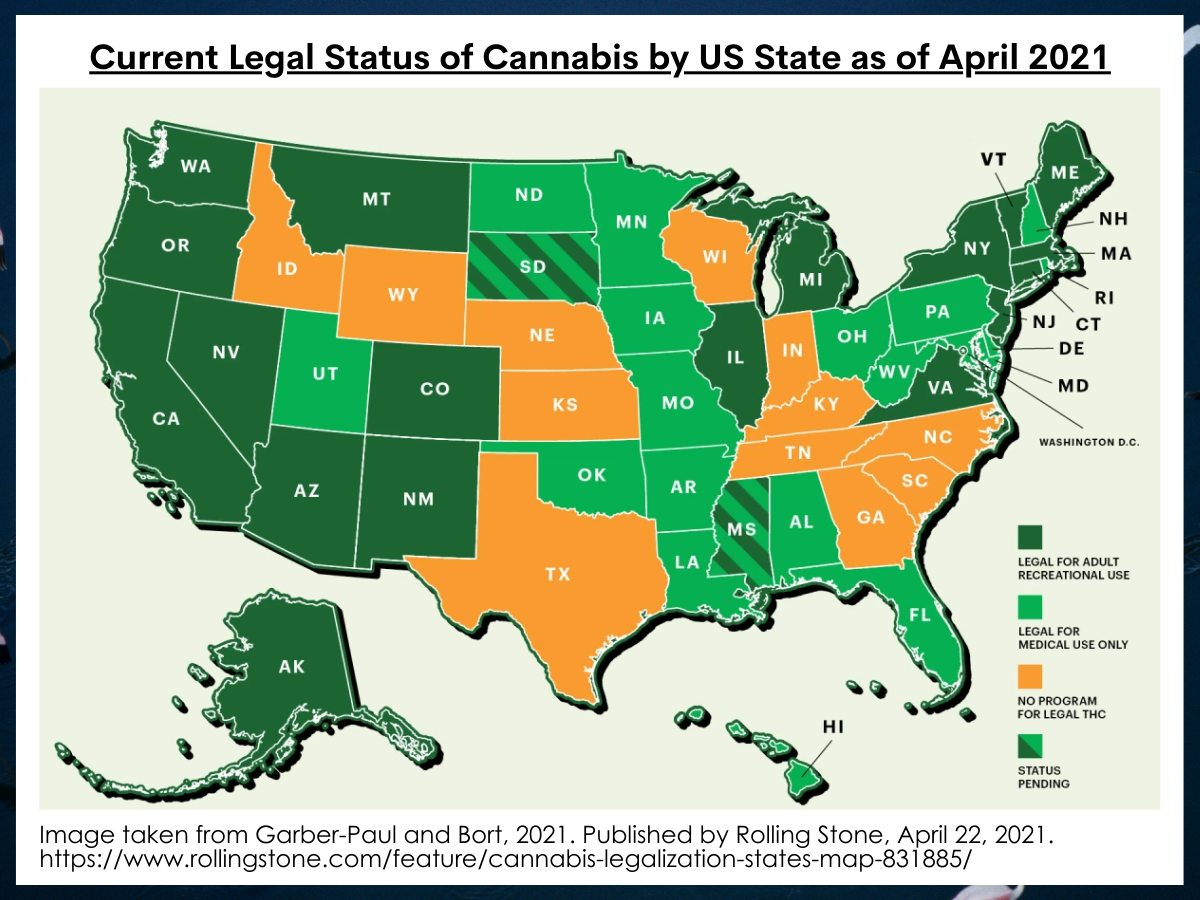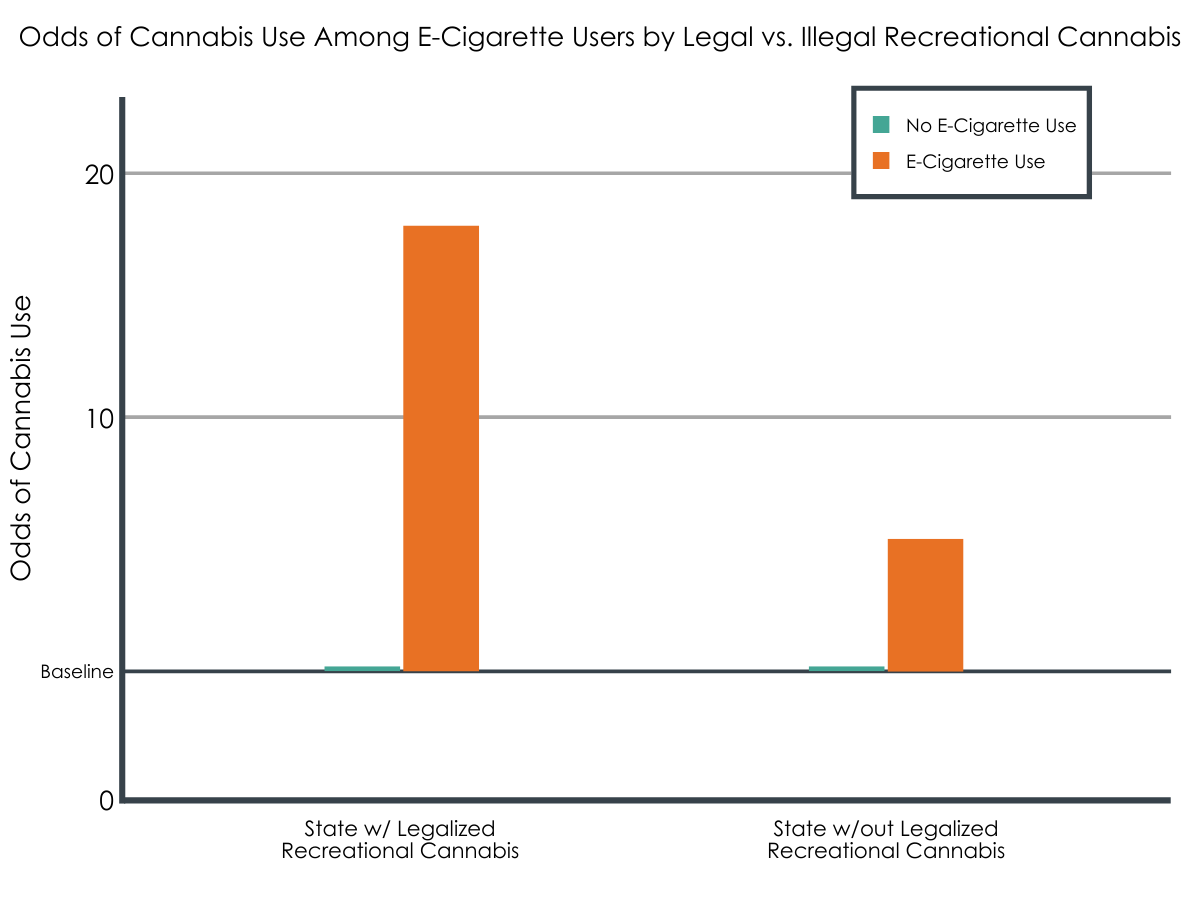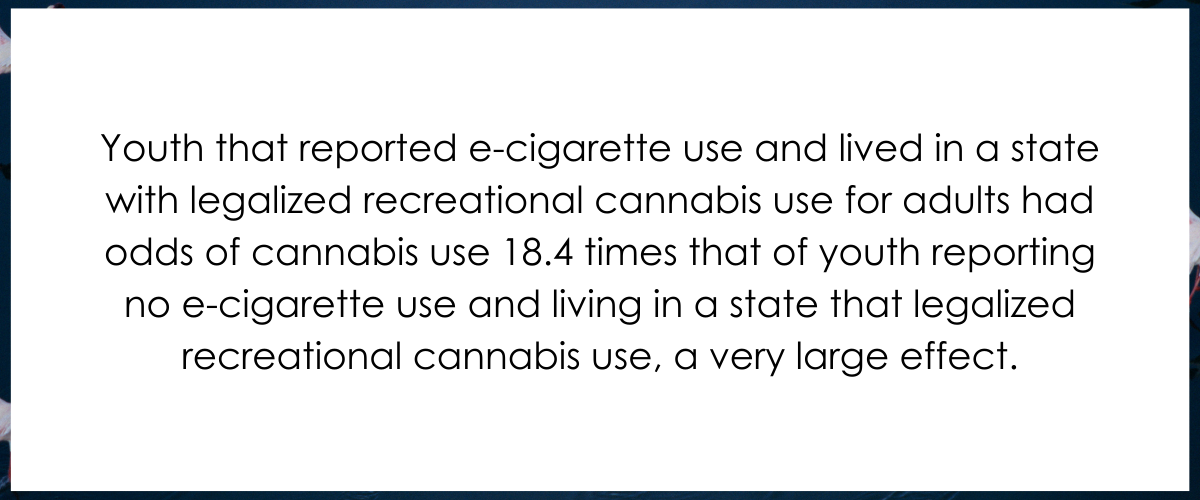Unintended spillover effects of cannabis legalization for youth who use e-cigarettes
With cannabis laws and polices changing across the United States, it is important to understand the potential risk to youth so they can be addressed. Youth e-cigarette use (i.e., vaping) is a well-studied occurrence with unique physical and behavioral health risks. Cannabis use initiation following vaping is one risk. Both vaping and cannabis use have potentially detrimental effects on young people’s brains and social development. This study explores if the connection between youth e-cigarette and cannabis use is amplified by state-level cannabis legalization for adults.
WHAT PROBLEM DOES THIS STUDY ADDRESS?
Since 2012, when Colorado and Washington first legally approved adult recreational cannabis use, eighteen states, two territories, and the District of Columbia have now legalized recreational cannabis use for adults. The effects of legalization have sparked considerable debate. Legalization does not appear to affect crime rates, traffic accidents or fatalities, and it may be good for job creation and state budgets. However, recreational cannabis legalization for adults has also been found to increase the likelihood of youth cannabis use, and daily cannabis use is on the rise nationally. Clinical and public health recommendations related to effects of cannabis legalization on adolescent cannabis use, however, would benefit from greater attention to contexts and individual factors, including other health risk behaviors.

Cannabis is consistently the most widely used drug apart from alcohol among youth. Cannabis use during adolescence has consequences including increasing cognitive deficits as well as increased the odds of other substance use, mental health problems and lower socioeconomic status.
Although cannabis use among youth has been relatively stable during the past 25 years, e-cigarette use (i.e., vaping) has seen an accelerated rise in prevalence among youth aged 12-18. The increase in prevalence among 8th, 10th, and 12th graders from 2019 to 2020 was one the largest increases ever observed in the 47 years that the Monitoring the Future study has collected substance use behaviors among youth in the United States, and in 2021, 8.9%, 15.6%, and 24% of 8th, 10th, and 12th graders respectively reported vaping in the last 30 days. Although vaping may be less harmful, overall, than traditional combustible cigarettes or smokeless tobacco, vaping presents unique health risks. Potential physical health risks include exposure to heavy metals from batteries and heating coils and vaping liquids that can be respiratory irritants. Vaping has also been linked with e-cigarette or vaping product use-associated lung injury (EVALI), which has led to dozens of deaths and thousands of cases of acute respiratory compromise. Nicotine use also has been linked to other substance use, including cannabis, increased prevalence of mental illness, and delayed learning and memory. More specifically, e-cigarette use has been found to be an independent risk factor for later cannabis use.
Understanding how cannabis legalization impacts youth behaviors may inform prevention and intervention strategies. Furthermore, practitioners and families may benefit from knowing how policies may amplify the risk for existing youth behaviors (e-cigarette use) that increase the likelihood of cannabis use. In this study, Duan and colleagues investigate the relationship between e-cigarette on cannabis use as well as if that association differs in states that have legalized recreational cannabis use for adults.
HOW WAS THIS STUDY CONDUCTED?
This was an observational study that used data from the first four waves (2013-2018) of the Population Assessment of Tobacco and Health Study (PATH), a nationally representative longitudinal study exploring tobacco use and how it affects the health of non-institutionalized people in the United States. For the present study, youth aged 12-17 that reported to never have used cannabis at a Waves 1-3 were eligible, which resulted in 19,503 youth. The primary outcome was self-reported past 30-day cannabis use at 12-month follow-up waves. The key exposure was past 30-day e-cigarette use. Both cannabis use and e-cigarette use were transformed into binary (yes/no) variables for the analysis. Recreational cannabis legalization status for each state was obtained from the NIH Alcohol Policy Information System. Internalizing and externalizing mental health conditions were also measured using the GAIN-SS, a validated short screener used to identify individuals that may have one or more behavioral health conditions. Age, sex, race/ethnicity, parental education, and combustible tobacco use were also collected.
Researchers evaluated the association between baseline e-cigarette use and subsequent cannabis use over three 12-month follow-up periods (Wave 1 to Wave 2, Wave 2 to Wave 3, and Wave 3 to Wave 4) while accounting for the survey wave, individual characteristics, and state recreational cannabis legalization status. They also conducted an additional analysis that explored if the relationship between e-cigarette and cannabis use was different for youth that lived in a state where recreational cannabis use has been legalized for adults.
Among the eligible sample at Wave 1, 49.0% were female, 54.3% were non-Hispanic white, 14.1% were non-Hispanic black, 9.3% were non-Hispanic other, and 22.3% were Hispanic. Prevalence of past 30-day e-cigarette use ranged from 0.6% in Wave 1 to 1.4% in Wave 3. High severity internalizing mental health problems were found among 18.4% to 20.5% of youth across Waves 1-3, and high severity externalizing mental health problems were found among 28.1% to 29.7% of youth across Waves 1-3. The prevalence of past 30-day cannabis use was 2.3%, 2.4%, and 3.2% in Waves 2-4.
WHAT DID THIS STUDY FIND?
E-cigarette users had increased odds of past 30-day cannabis use.
Overall, youth that reported e-cigarette use were more likely to report past 30-day cannabis use 12 months later compared to youth that did not report using e-cigarettes in the past 30 days at baseline. Youth reporting e-cigarette use had odds of cannabis use 5.1 times that of youth that did not report past 30-day e-cigarette use.
Recreational cannabis use legalization for adults amplifies the relationship between e-cigarette on cannabis use for youth.

Youth that reported e-cigarette use and lived in a state with legalized recreational cannabis use for adults had odds of cannabis use 18.4 times that of youth reporting no e-cigarette use and living in a state that legalized recreational cannabis use, a very large effect. Youth reporting e-cigarette use and not living in a state that legalized recreational cannabis use had odds of cannabis use 5.1times that of youth not reporting e-cigarette use and living in those states. In other words, the link between e-cigarette and cannabis use for youth exist across states, but it is much stronger in states with legalized recreational cannabis use.

High severity internalizing and externalizing problems increase odds of cannabis use.
Youth that were identified with high severity internalizing problems (e.g., anxiety) had odds of cannabis use 1.49 times, a 49% increase in odds, that of youth with low severity internalizing problems. Similarly, youth flagged with high severity externalizing mental health problems (e.g., oppositional behavior) had odds of cannabis use 1.8 times that of those with low severity externalizing problems.
WHAT ARE THE IMPLICATIONS OF THE STUDY FINDINGS?
Across the United States, more states are legalizing recreational cannabis use for adults. Currently, 18 states, 2 territories, and the District of Columbia have legalized recreational cannabis use for adults. There is also increasing pressure from advocacy organizations such as the Drug Policy Alliance and states such as California, Alaska, Georgia, Iowa, Massachusetts, Michigan, New Jersey, and Pennsylvania to reschedule or at least allow state authority for cannabis policy since cannabis remains a Schedule I illegal substance at the federal level.
Although some evidence suggests that legalization of recreational cannabis use for adults has benefits, such policies may also have negative consequences for youth. In the context of changing cannabis policies, cannabis is the most popular illicit substance used by youth. Cannabis use during this key developmental period can lead to cognitive deficits and other mental health problems. Furthermore, the emergent rise in legalization is also accompanied by a historic rise in e-cigarette use among youth. This study replicated a previously established relationship between youth e-cigarette and cannabis use and sought to determine if the relationship differed in states where recreational cannabis use has been legalized for adults.
The present study aligns with previous research showing that youth who use e-cigarettes are more likely to report later cannabis use. Millions of youth continue to report recent e-cigarette use in the United States, and this study adds to the health risk of youth e-cigarette use. In this study, the researchers found that youth who had never used cannabis but reported recent e-cigarette use were much more likely to report recent cannabis 12-months later compared to youth who did not report recent e-cigarette use at baseline. The increased risk of cannabis use among e-cigarette users presents a potential opportunity for clinicians and family members to identify youth at risk of future cannabis use and implement prevention/intervention strategies. Externalizing and internalizing mental health difficulties were also risk factors for later cannabis use. Early screening for mental health problems may also assist in identifying youth in need of targeted services, which may also help reduce the odds of cannabis use.
Individual-level risk factors occur in the context of larger systems, such as state-level policy. Although previous research has noted how cannabis legalization increases youth cannabis use broadly, analysis in this study showed that youth who have never used cannabis but reported e-cigarette use and live in states with legalized recreational cannabis use for adults had a very substantial increase in the odds of recent cannabis use 12 months later. The massive increase in the likelihood of cannabis use among e-cigarette users suggests that state-level recreational cannabis use policy for adults may amplify the individual-level risk factor of e-cigarette use for later cannabis use among youth. This appears to be occurring despite a legal age limit of 21 years old being set in these states – legal cannabis for adults appears to spill over into much higher rates of illegal use among the younger age groups, and even more so among youth who are also using e-cigarettes.
Some policy has shifted to address the marketing of e-cigarettes to youth. Yet, there remains extensive exposure to e-cigarette marketing, and youth continue to have high rates of e-cigarette use. Moreover, cannabis policy appears to be further shifting toward legalization. Although cannabis laws and policies may have some economic benefits for adults, such as job creation, additional work is needed to clarify unintended risks to youth and what behaviors or contexts heighten those risks.
Researchers in this study highlight how e-cigarette use may be one important risk indicator or pathway to cannabis use initiation particularly in states that have legalized recreational cannabis use. It may be that the legalized status of cannabis use for recreational use lowers youth perceptions of its potential harms, and through cannabis advertising, adult role-modeling, and increased availability and accessibility, more youth want to try it sooner and are able to obtain it more easily. That said, more research is needed to understand the actual pathways through which state cannabis policies influence cannabis use among young e-cigarette users.
- LIMITATIONS
-
- The study is unable to explore if state-level cannabis use policy caused cannabis use among youth. Although individual-level factors (e.g., e-cigarette and cannabis use) were collected over time, the status of state-level policy was only collected at one time point.
- The researchers relied on retrospective recall of past 30-day e-cigarette and cannabis use. Despite the prevalence of such measures, there is possible response bias such that participants may respond in ways that are perceived to be socially desirable. Additionally, recall is imperfect and may result in inaccuracies.
- Cannabis policy in the United States is quickly changing, and the results from this study may not generalize to current times or other countries.
- The number of youth who reported e-cigarette use living in states with legalized recreational cannabis use was relatively small compared to the population of youth. Thus, estimates of effects have a wide margin of error.
- The authors were unable to include other potentially important confounding variables such as risk perceptions or perceived availability of e-cigarettes or cannabis. However, the researchers did include a wide range of individual characteristics.
BOTTOM LINE
In this nationally representative cohort study, researchers identified nearly 20,000 youth aged 12-17 who reported to never have used cannabis across the first three waves of the PATH study. The study explored the link between e-cigarette use and later cannabis use as well as if this relationship was different in states where recreational cannabis use had been legalized for adults. The study showed a large increase in odds of cannabis use 12 months after reporting recent e-cigarette use after accounting individual demographics. The association between e-cigarette and cannabis use was amplified in states with legalized recreational cannabis use – youth who reported e-cigarette use and lived in state with legalized recreational cannabis use had a substantial increase in odds of later cannabis use compared to youth living states that legalized recreational use but did not report e-cigarette use. Future research should explore the potential spillover effects of adult cannabis legislation on youth, particularly youth who use e-cigarettes. Mental health and e-cigarette screening and intervention in primary care are likely to reduce and unlikely to increase cannabis initiation among youth.
- For individuals and families seeking recovery: This study showed that youth who use e-cigarettes are more likely to report later cannabis use and that this association much larger in states that have legalized recreational cannabis use for adults. Internalizing and externalizing mental health problems were also tied to later cannabis use. If you or a loved one currently use e-cigarettes, education surrounding the health risk of continued use as well as the risk of cannabis use during adolescence are likely to help reduce harm. Additionally, if you or a loved one live in a state where recreational cannabis use is legalized for adults, it may be especially important to understand the risks of both e-cigarette and cannabis use.
- For treatment professionals and treatment systems: E-cigarette and cannabis use are both public health concerns for youth. The researchers in this study replicated previous findings that youth who report e-cigarette use are more likely to initiate cannabis use than youth who do not use e-cigarettes. Furthermore, the researchers found that this relationship was much larger for youth living in states where recreational cannabis use has been legalized for adults. Treatment professionals and systems should consider incorporating the added risk of living in a state that has legalized adult recreational cannabis use for youth who use e-cigarettes. Furthermore, screenings specially for e-cigarette use and internalizing and externalizing mental health conditions are likely to help reduce the odds of future cannabis use.
- For scientists: There was a very strong relationship between e-cigarette and cannabis use for youth living in states that legalized recreational cannabis use for adults – the odds of cannabis use among e-cigarette users in these states were 18.4 times that of youth that did not report e-cigarette use in these states. In future studies, researchers should consider incorporating policy changes as a time-varying predictor to isolate the effect of state-level policy. Furthermore, future research might specifically target youth e-cigarette users to reduce the resulting sampling error of the relatively small sample of youth e-cigarette users in this population-level study. Investigation of youth risk perceptions regarding e-cigarette and cannabis use is also likely to improve evidence of the relationship between e-cigarette use and later cannabis use.
- For policy makers: E-cigarette and cannabis use among youth are major public health concerns. The researchers in this study identified e-cigarette use as a risk factor for later cannabis use among youth. Furthermore, the research team found that this risk was amplified by state-level legalization of recreational cannabis use for adults. These findings suggest that further education and policy surrounding e-cigarette use among youth is likely to benefit youth health. In addition, these findings suggest that state-level cannabis policy may have harmful spillover effects for youth who use e-cigarettes. Policy makers should consider these unintended consequences of adult-focused legislation as well as possible funding opportunities to empirically study these spillover effects and pathways that lead to youth cannabis use.
CITATIONS
Duan, Z., Wang, Y., Weaver, S. R., Spears, C. A., Zheng, P., Self-Brown, S. R., Eriksen, M. P., & Huang, J. (2022). Effect modification of legalizing recreational cannabis use on the association between e-cigarette use and future cannabis use among US adolescents. Drug and Alcohol Dependence, 233, 109260. doi: 10.1016/j.drugalcdep.2021.109260

